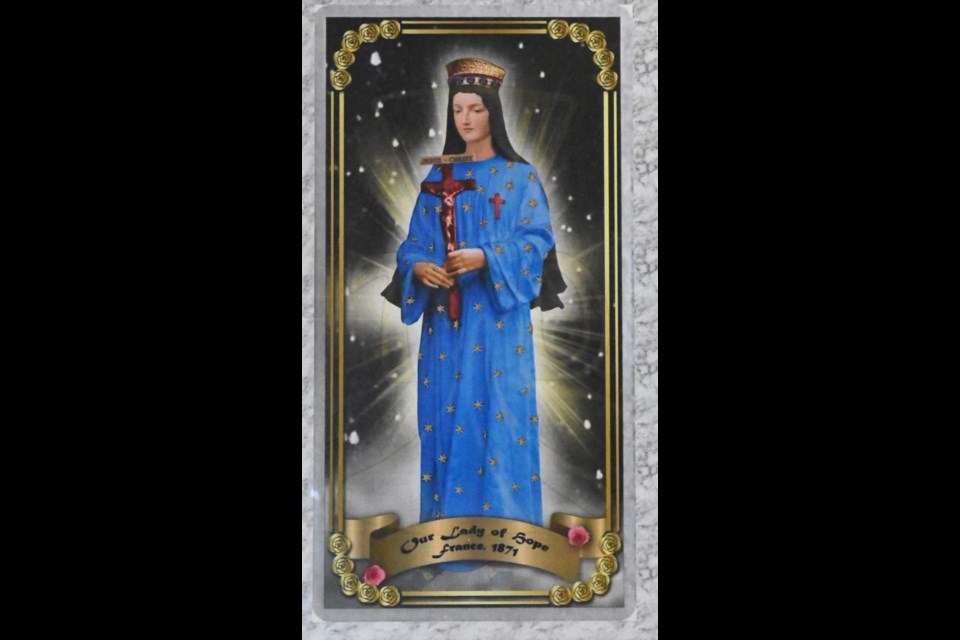After approving Our Lady of Hope as the new name for the Catholic side of the joint-use school, trustees with Holy Trinity School Division also learned the history behind the namesake.
During the March 18 board meeting, division chaplain Lisa Busta read the “fascinating” story about the Virgin Mary’s appearance 153 years ago in France. She also displayed a picture of the woman in a blue and yellow robe holding a maroon cross — as she was then seen — that the chaplain noted are also the colours of St. Mary and Sacred Heart schools.
“You can’t even make that up. That is just perfect, perfect,” Busta said.
On Jan. 17, 1871, the apparition appeared over Pontmain, France, a rural community with a strong Catholic heritage. A boy working with his father in the barn walked outside and gazed at the sky, where he noticed one area without stars.
Suddenly, he saw an apparition “of a beautiful woman smiling at him” while wearing a blue gown covered in golden stars and a black veil under a golden crown. While the boy’s parents couldn’t see anything, the younger brother could.
“Although she was puzzled because her boys were usually very truthful, (the mother) suggested that it might be the Blessed Virgin and that they should all say five Our Fathers and five Hail Marys in her honour,” Busta said.
The family then went inside for supper, and afterward, the boys went outside again and noticed the apparition’s continued presence. The schoolteacher came, but because she couldn’t see anything, she went and brought three other children to see their reactions.
Those girls “expressed their delight at the apparition,” describing it as the boys had done. Meanwhile, the crowd had grown to 60 people — it included the priest — and the adults could still not see anything. However, the group said the rosary as the children described the changes they were seeing.
A blue oval frame with four candles — two at the shoulders and two at the knees — was forming around the Virgin Mary while a short, red cross had appeared over her heart. The figure and the frame grew twice the size until the stars around her attached to her dress.
“So cool,” Busta whispered excitedly.
As another prayer was being recited, the children said a banner on which letters were appearing unrolled underneath the apparition’s feet. The phrase said, “But pray, my children. God will soon answer you. My son allows Himself to be moved (by compassion).”
“The children were beside themselves with joy at the beauty of the lady and her smile, but her expression then changed to one of extreme sadness,” Busta said, with a large red cross appearing before her and Jesus hanging on it in a darker shade of red.
One star then lit the four candles while the crucifix vanished. The children then reported that a white veil rose over the Virgin Mary and gradually covered her; she disappeared around 9 p.m.
The Roman Catholic Church held a canonical inquiry into the apparition in March 1871, while in May, the local bishop questioned the children. The inquiry was continued later in the year, with theologians asking questions and a doctor conducting a medical examination.
Satisfied with the investigations, the bishop declared in February 1872 — a year later — that what the children had said was true.
The Franco-Prussian war — which began in 1870 — ended on March 1, 1871, a few weeks after the appearance of the Blessed Virgin, with all of Pontmain’s soldiers coming home.
“She just said, ‘You got to have hope, you gotta pray and you gotta believe,’” Busta added. “And that’s a beautiful message still to this day.”
The next Holy Trinity board meeting is Monday, April 8.




